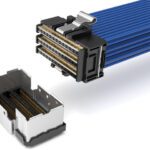Industry Leaders Collaborate on QSFP Module Speeds to 400Gb/s
A consortium is collaborating to define double-density QSFP modules through a multi-source agreement.
The QSFP-DD Multi Source Agreement (MSA) Group recently announced plans to develop high-speed, double-density quad small-form-factor pluggable (QSFP-DD) interfaces. The primary objective of the MSA group is to define the specifications and promote industry adoption of the QSFP-DD.
“Establishment of this MSA reflects continuing industry demand for interfaces that support higher data rates while consuming less I/O panel space,” says Bob Hult, director of product technology at Bishop & Associates. “Industry standardized pluggable modules that deliver 400Gb/s provide system designers assurance of performance, plug compatibility, and multiple competitive sources.”
The MSA founder-promoters include Broadcom, Brocade, Cisco, Finisar, Foxconn Interconnect Technology, Intel, Juniper Networks, Lumentum, Luxtera, Mellanox Technologies, Molex, Oclaro, and TE Connectivity.
“The need for high-speed solutions is unmistakable,” said Scott Sommers, group product manager, Molex. “This MSA is a critical part of meeting that need, and Molex will contribute its leadership in complete I/O solutions — including connectors, copper cable, and fiber optics. We are delighted to be working with Cisco and other partners to meet the challenge of developing a double-density interface that meets or exceeds industry expectations.”
According to the Cisco Visual Networking Index (VNI) Forecast, factors expected to drive exponential traffic growth include global increases in Internet users, personal devices and machine-to-machine (M2M) connections, faster broadband speeds, and the adoption of advanced video services. The development of QSFP-DD will address this increased global bandwidth consumption by enabling very high bandwidth interfaces.
“With a clear trend towards hyper-converged fabrics, customers need an aligned switch silicon and optics roadmap,” said Luca Cafiero, senior vice president and general manager at Cisco. “Global IP traffic is expected to reach 1.4 zettabytes next year, reflecting a CAGR from 2012 to 2017 of 23%. All players involved in network architecture will have to step up their game to meet this demand, and the MSA for QSFP-DD is a big step in that direction. We are confident that, with industry leaders like Molex, we can help to lead the development of high-speed technology that will be broadly used throughout the industry.”
The latest Cisco Cloud Scale ASIC technology enables cost-effective 36-port 100GbE in a single-chip design. Assuming an 18-month silicon innovation cycle, these bandwidth capabilities will double and quadruple in the next two to three years. Having a QSFP-DD with a roadmap towards 2x100G and 400G interfaces will allow for close alignment of switch ASIC and optics capability.
The new QSFP-DD interface expands on the QSFP pluggable form factor, a widely adopted four-lane electrical interface used across Ethernet switches that enables interconnection between switches or to servers. QSFP’s four electrical lanes operate at 10Gb/s or 25Gb/s, providing solutions for 40Gb/s or 100Gb/s aggregate. The new QSFP-DD pluggable form factor’s electrical interfaces will employ eight lanes that operate up to 25Gb/s NRZ modulation or 50Gb/s PAM-4 modulation, providing solutions up to 200Gb/s or 400Gb/s aggregate. This can enable up to 14.4Tb/s aggregate bandwidth in a single switch slot and address rapid data-center traffic growth.
“The front-panel form factor has been maintained so that these QSFP-DD stacked cages will fit the same front-panel openings as current stacked QSFP cages,” says David Brearley of Bishop & Associates. “The cages are about 16mm deeper on the host board to allow for twice as many contacts between the modules and the host boards. Note that the QSFP-DD module board has two rows of 28 pads – one row exactly like QSFP today and the second set of pads deeper on the module board. The deeper mating contact beams slide over the first row of pads to reach the second. If a QSFP module is plugged into a QSFP-DD cage, it will mate with the front-most row of contacts only and will be fully functional, meaning that all existing QSFP modules will work in the new QSFP-DD cages.”
Systems designed to support QSFP-DD modules will also be backwards-compatible, allowing them to support the existing QSFP family of modules. This will provide a high degree of flexibility to end users and system designers.
The QSFP-DD MSA Group is addressing the technical challenges of achieving a double-density interface and ensuring mechanical, electrical, thermal, and signal-integrity interoperability for module components produced by different manufacturers. This effort enables faster implementation and easier operation of the QSFP-DD pluggable interface in networking equipment.
With its ability to quadruple aggregate switch bandwidth while maintaining port density, QSFP-DD will play a pivotal role in enabling the networking industry to support continuing growth in network bandwidth demand.
[hr]
- MikroElektronika Intel Joule click shields - May 10, 2017
- Right Angle Board-to-Board Battery Connectors Suit High Shock and Vibration Applications - May 10, 2017
- Compression Pulling Head Family Offers Six Sizes - May 3, 2017






